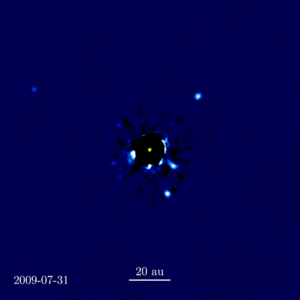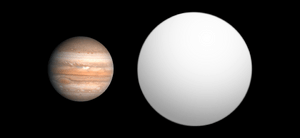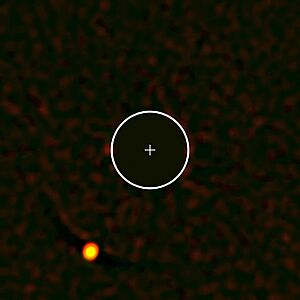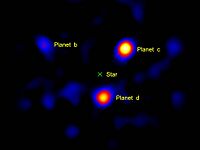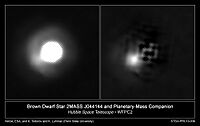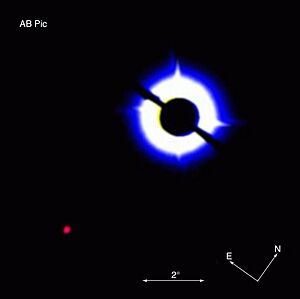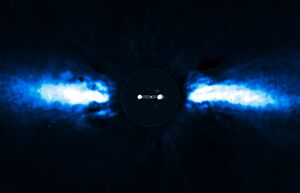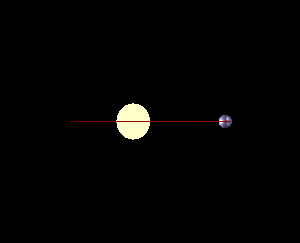Exoplanet facts for kids
An exoplanet (also called an extrasolar planet) is a planet that orbits a star other than our Sun. So, it's a planet found outside our own Solar System. Scientists first thought they might have found an exoplanet in 1917. But they didn't officially confirm finding one until 1992.
Today, we know there are thousands of exoplanets! The James Webb Space Telescope (JWST) is helping us find even more. It also helps us learn about these planets. We can study what they are made of and if they could have life.
Scientists use many ways to find exoplanets. Two main methods are transit photometry and Doppler spectroscopy. These methods often find planets very close to their stars. About 1 in 5 Sun-like stars might have an "Earth-sized" planet. These planets are in the "habitable zone". This is where liquid water could exist. Our Milky Way galaxy might have billions of these planets.
The smallest exoplanet we know is called Draugr. It's about twice the size of our Moon. The biggest is HR 2562 b. It is about 30 times bigger than Jupiter. But some scientists think it might be a brown dwarf instead of a planet. Brown dwarfs are bigger than planets but smaller than stars. Exoplanets can orbit their stars very quickly, in less than an hour. Others take thousands of years to complete one orbit.
Most exoplanets found so far are in our Milky Way galaxy. But there is some proof that planets exist in other galaxies too. The closest exoplanets are about 4.2 light-years from Earth. They orbit a star called Proxima Centauri.
Finding exoplanets has made people even more interested in finding extraterrestrial life. Scientists are very interested in planets in the "habitable zone". This zone is sometimes called the "goldilocks zone". It's where the temperature is just right for liquid water. Liquid water is needed for life as we know it.
Some planets don't orbit any star at all. These are called rogue planets. They just float freely in space. There could be billions of these rogue planets in the Milky Way.
Contents
What is an Exoplanet?
The official definition of a "planet" from the International Astronomical Union (IAU) is mostly for planets in our Solar System. But they also have a working definition for exoplanets.
An exoplanet is usually defined as:
- An object with a mass below 13 times the mass of Jupiter. This is the limit for nuclear fusion of deuterium (a type of hydrogen).
- It must orbit a star, a brown dwarf, or the remains of a star.
- It must also have a certain mass ratio compared to its central object.
Objects bigger than 13 Jupiter masses are usually called brown dwarfs.
Naming Exoplanets
Exoplanets are named using a system from the International Astronomical Union (IAU). The name starts with the name of its parent star. Then, a small letter is added. The first planet found around a star gets the letter "b". The next one gets "c", and so on. For example, the first planet found around the star 51 Pegasi is called 51 Pegasi b. If several planets are found at the same time, the one closest to the star gets the next letter.
How We Found Exoplanets
For a long time, people wondered if planets existed outside our Solar System. But there was no way to know for sure.
The first hint of an exoplanet was seen in 1917. It was around a star called Van Maanen 2. But scientists didn't realize what it was at the time.
The first real scientific detection happened in 1988. Then, in 1992, astronomers confirmed finding planets around a pulsar called PSR B1257+12. A pulsar is a very dense, spinning star that sends out radio waves.
The first exoplanet found orbiting a normal star like our Sun was in 1995. It was a giant planet orbiting 51 Pegasi. This discovery really kicked off the search for exoplanets!
Most exoplanets are found using indirect methods. This means we don't see the planet directly. Instead, we look for how the planet affects its star.
In 2022, scientists confirmed the 5000th exoplanet! And in 2023, the James Webb Space Telescope found its first exoplanet, LHS 475 b. It's an Earth-like exoplanet.
Early Ideas
People have thought about other worlds for a long time. In the 1500s, an Italian thinker named Giordano Bruno believed that stars were like our Sun. He thought they also had planets orbiting them.
Later, Isaac Newton also wrote about this idea in the 1700s. He wondered if other stars had systems like our Sun.
Confirmed Discoveries
As of August 2023, over 5,500 confirmed exoplanets are listed.
In 1988, Canadian astronomers first suggested a planet around Gamma Cephei. But it was hard to be sure at the time. In 2003, better tools finally confirmed it.
The first truly confirmed exoplanets were found in 1992. They orbited a pulsar called PSR B1257+12. These planets likely formed from the leftover material after the star exploded.
Then, in 1995, Michel Mayor and Didier Queloz found the first exoplanet orbiting a normal star, 51 Pegasi. This was a huge step! They even won a Nobel Prize for it in 2019. New technology helped astronomers find many more planets. They could see how planets pulled on their stars.
At first, most exoplanets found were "hot Jupiters". These are huge planets that orbit very close to their stars. Scientists were surprised because they thought giant planets should form far away. But now we know there are many different kinds of exoplanets.
In 2014, NASA announced 715 new exoplanets found by the Kepler Space Telescope. Most of these were between the size of Neptune and Earth.
In 2015, NASA announced Kepler-452b. This planet is almost the size of Earth and orbits in the habitable zone of a Sun-like star.
In 2018, scientists found Wolf 503b. It's twice the size of Earth and orbits an "Orange Dwarf" star. It's special because it's in a "gap" where planets of that size are rarely found.
In 2020, the TESS mission found TOI 700 d. This was the first Earth-sized planet found in a habitable zone by TESS.
How We Find Exoplanets
Direct Imaging
Planets are very dim compared to their stars. A star like our Sun is a billion times brighter than the light reflected from its planet. It's like trying to see a tiny firefly next to a giant spotlight! Special telescopes can block out the star's light. This helps us see the planet. But even then, only very large planets far from their stars can be seen this way.
Most exoplanets are found using indirect methods.
Indirect Methods
- Transit Method
If a planet passes in front of its star, the star's light dims a tiny bit. The amount of dimming tells us about the planet's size. This method works only if the planet's orbit lines up with our view from Earth. The Kepler telescope used this method a lot.
- Radial Velocity (Doppler Method)
As a planet orbits a star, it pulls on the star a little. This makes the star wobble. We can measure this wobble by looking at the star's light. The light changes slightly due to the Doppler effect. This tells us how fast the star is moving towards or away from us.
- Transit Timing Variation (TTV)
If a star has more than one planet, they can pull on each other. This can make a planet's transit happen a little earlier or later than expected. These small changes can tell us if another planet is there, even if we can't see it transit.
- Gravitational Microlensing
Sometimes, a star and its planet can act like a giant lens. They can bend the light from a star far behind them. This makes the background star look brighter for a short time. If a planet is orbiting the lensing star, it can cause a small extra flicker in the light. This method is good for finding planets that are far from their stars.
- Pulsar Timing
A pulsar is a super-dense star that spins very fast. It sends out radio waves like a lighthouse. If planets orbit the pulsar, they can make these radio pulses arrive a tiny bit early or late. This is how the very first exoplanets were confirmed.
How Planets Form
Planets can form within a few million years after their star forms. We can't watch a single planet form from start to finish. But by looking at many different planetary systems of different ages, we can learn how they grow. Young planets often have large envelopes of hydrogen and helium gas. Over time, these gas layers can cool and shrink. Some of the gas might even escape into space.
Stars with Planets
On average, there is at least one planet for every star. About 1 in 5 Sun-like stars have an "Earth-sized" planet in the habitable zone.
Most known exoplanets orbit stars similar to our Sun. These are called main-sequence stars. Stars with more "metals" (elements heavier than hydrogen and helium) are more likely to have giant planets.
Some planets orbit one star in a binary star system (two stars orbiting each other). Some even orbit both stars! These are called circumbinary planets.
Exoplanet Features
Color and Brightness
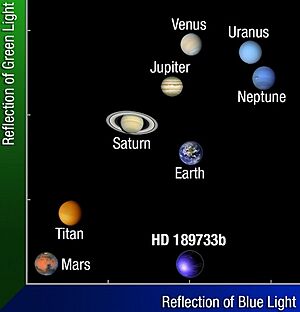
In 2013, scientists figured out the color of an exoplanet for the first time. The planet HD 189733b appears a deep dark blue. This color comes from tiny glass particles in its atmosphere. Other exoplanets have been found to be magenta or reddish.
How bright a planet looks depends on how far away it is. It also depends on how much light it reflects (its albedo). And how much light it gets from its star.
The darkest known planet is TrES-2b. It's a "hot Jupiter" that reflects less than 1% of its star's light. That's darker than coal!
Magnetic Field
In 2014, scientists found hints of a magnetic field around HD 209458 b. This was the first time a magnetic field was detected on an exoplanet. It's about one-tenth as strong as Jupiter's.
Magnetic fields on exoplanets might create auroras, like the Northern Lights on Earth. These auroras could send out radio waves that we could detect. This might help us figure out how fast an exoplanet spins.
Rings
One star, 1SWASP J140747.93-394542.6, has an object orbiting it with a huge ring system. It's much bigger than Saturn's rings. We don't know if the object is a planet or a brown dwarf.
The rings of planets in our Solar System line up with their planet's equator. But for exoplanets close to their star, the star's gravity could pull the outer rings into a different alignment. This could create a warped ring system.
Moons
Scientists are also looking for moons around exoplanets, called exomoons. In 2013, a possible exomoon was found around a rogue planet. In 2018, there was evidence of a large exomoon orbiting Kepler-1625b.
Atmospheres
We have found atmospheres around several exoplanets. The first one was seen around HD 209458 b in 2001.
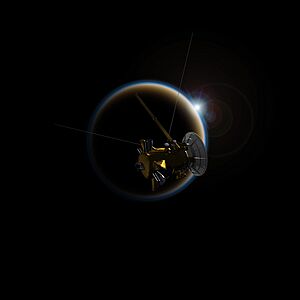
Scientists have detected different gases in exoplanet atmospheres. They can also see temperature differences between the day and night sides of planets.
Comet-like Tails
Some small rocky planets that are very close to their stars are evaporating. They leave a trail of gas and dust, like a comet. For example, KIC 12557548 b is losing its atmosphere. In 2015, scientists found that GJ 436 b was also evaporating. It had a giant cloud and a long tail millions of miles long.
Surface Features
Surface Temperature
We can guess an exoplanet's temperature by how much light it gets from its star. For example, OGLE-2005-BLG-390Lb is estimated to be very cold, about -220°C. But these are just guesses. We don't always know how reflective the planet is. Also, things like the greenhouse effect can change the temperature.
Some planets have had their temperature measured more directly. This is done by looking at the heat (infrared radiation) they give off. For example, HD 189733b is very hot. Its day side is about 932°C, and its night side is about 700°C.
Could Exoplanets Have Life?
As we find more exoplanets, we learn more about them. This helps us think about the possibility of life on planets beyond our Solar System. We look for signs of life that would change a planet's environment. For example, molecular oxygen (O2) in Earth's atmosphere comes from living things. So, finding O2 on an exoplanet could be a sign of life.
A planet that could support life needs to orbit a stable star. It also needs to be at the right distance. This distance allows for liquid water on its surface.
Habitable Zone
The habitable zone around a star is where the temperature is just right for liquid water. It's not too hot for water to evaporate. And it's not too cold for water to freeze. The size and age of a star change where its habitable zone is.
Planets with more water might have less water vapor in their atmosphere. This means a weaker greenhouse effect. So, a "desert planet" could have water closer to its star. Planets with thick hydrogen atmospheres could have surface water much farther out.
Planets that spin slowly can create thick clouds. These clouds reflect more light. So, these planets could be habitable even closer to their star.
Ice Ages
Even planets in the habitable zone can sometimes freeze over. If a planet cools, more ice forms. Ice reflects sunlight, causing even more cooling. This can lead to a "snowball" state where the planet is mostly frozen. But then, volcanoes can release carbon dioxide. This gas builds up in the atmosphere and creates a greenhouse effect. This warms the planet and thaws it again.
Potentially Habitable Planets
Scientists have found several exoplanets that might be able to support life.
- Kepler-62f, Kepler-186f, and Kepler-442b are good candidates.
- Kepler-186f is about the same size as Earth. It orbits a red dwarf star in the outer part of its habitable zone.
- Proxima Centauri b is the closest potentially habitable exoplanet. It's about 4.2 light-years away. It's at least 1.27 times the mass of Earth.
Earth-sized Planets
- In 2013, scientists thought that about 22% of Sun-like stars in the Milky Way might have an Earth-sized planet in the habitable zone. This could mean billions of potentially habitable Earths in our galaxy!
- Kepler-186f, found in 2014, is 1.2 times Earth's radius. It's in the habitable zone of a red dwarf.
- Kepler-452b, found in 2015, is 1.63 times Earth's radius. It's the first near-Earth-sized planet found in the habitable zone of a G2-type star, which is like our Sun.
Planetary Systems
Exoplanets often live in systems with many planets orbiting the same star. These planets pull on each other with gravity. Sometimes, their orbits line up in special ways.
Some "hot Jupiters" orbit their stars backwards! This means they go the opposite way of their star's spin. Scientists think this might happen when planets form in crowded areas. There, other stars can pull on them and change their orbits.
Projects Searching for Exoplanets
- CoRoT – A space telescope that found the first rocky planet passing in front of its star.
- Kepler – A mission that looked for many exoplanets using the transit method.
- TESS – This mission searches for new exoplanets across the whole sky. It is expected to find at least 3,000 new exoplanets.
- HARPS – A very precise tool in Chile that finds planets by looking at how they pull on their stars.
- ESPRESSO – Another powerful tool in Chile that helps find rocky planets.
- ANDES – A future tool for the huge Extremely Large Telescope. It will help find and study planets.
See also
 In Spanish: Planeta extrasolar para niños
In Spanish: Planeta extrasolar para niños
- Detecting Earth from distant star-based systems
- Extrasolar planets in fiction
- Lists of exoplanets
- Planetary capture
- Habitable zone for complex life
Images for kids


